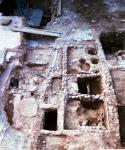Summary (English)
The characteristics of the architectural project to be executed (a basement in the whole surface of the site) made its excavation necessary over460.48 m2. This intervention has allowed us to establish a chronological sequence repeated throughout the excavated surface:
- First, the urban fabric of the 19th and 20th centuries, composed of seven farms, has been defined. The most modern of the buildings is a printing house built in 1989 and based on a 19th century dwelling. All properties were intended for residential and domestic use. However, one showed the presence of a carpenter’s workshop of the second half of the 20th century, established on the old dependencies of a 20th century winery.
- Below these were found levels from the 17th and the 18th centuries, associated with ceramic materials of this period. In them, the presence of glazed kitchen ceramics and remains of large jars stand out. They are residential and domestic constructions altered and reused during the construction of the urban fabric during the 19th and 20th centuries. The presence of a house with earthenware pitchers is significant in the geological base. Before the 17th century, the preserved archaeological remains are exclusively portable objects, without any trace of construction from the 15th and 16th centuries.
The archaeological material corresponds to fragments of golden and blue crockery dating between the end of the 14th century and the 16th century.
- Finally, the Islamic occupation of the area during the 12th and 13th centuries stands out. This period is characterized by the existence of numerous silos filled with materials that are dated in the second half of the 12th century and the 13th century. Due to the abundant ceramic fragments, bones and glass remains corresponding to this period, we attribute the function of middens to these structures, although we do not know its original functionality. Among the most prominent materials are common, common glazed, stamped, sgrained, combed, painted in manganese oxide ceramics, and some fragments of partial dry rope. Regarding the forms, they are fragments of large stamped jars, soup plates and Muslim oil lamps ( de pie alto and de piquera ). In addition, stone lathe bases and traces of the wheels placed on the top of these lathes have been recovered to place the pieces during their processing.
(translation by David Guerra Díaz)
- Gabriel Segura Herrero y José David Busquier Corbí
Director
- Gabriel Segura Herrero
- José David Busquier Corbí
Team
- Cristina Huesca Pérez
- Museo Arqueológico Municipal de Elda
Research Body
- Colegio Oficial de Doctores y Licenciados en Filosofía y Letras y en Ciencias de Alicante - Sección de Arqueología
Funding Body
- Ricote Patrimonial S. L.






![Download [PDF]](/excavation/skins/fasti/images/results/download_sml.png)

